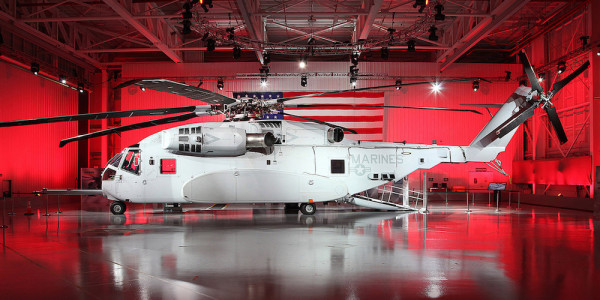

Lockheed Martin’s F-35 Lightning II is, without a doubt, the most expensive fighter craft in military history. Early production F-35A fighters clocked in at a whopping $130 million as of 2016, according to Popular Mechanics, and the Marine Corps’ order for the F-35B vertical takeoff and landing (VTOL) variant will likely end up somewhere around $122.8 million.
Well, Lockheed’s latest project makes the F-35 look like a used Camry. Meet the CH-53K King Stallion, the brand-new $138 million helicopter — and officially now the most expensive aircraft in the Pentagon’s arsenal.
On April 4, the Department of Defense finally approved the King Stallion for use as the Marine Corps’ brand-new heavy-lift helicopter. But Bloomberg reported on Wednesday that the official decision memo for the first run of 26 copters, signed by DoD weapons buyer James MacStravic, came with a nasty surprise: a hidden price increase of 6.9% to $31 billion for 200 helicopters.
That overall cost-hike ended up increasing the DoD’s “program acquisition unit cost” estimate from $131.2 million in August 2016… to a whopping $138.5 million today. As Rep. Niki Tsongas of Massachusetts, the top Democrat on the House Armed Services subcommittee, put it, that’s “a heck of a lot of money.”
To be fair, the King Stallion looks like one heck of a machine, able to haul three times the cargo of the long-lived Lockheed Super Stallion helo without any major change in dimensions. Here’s what Task & Purpose’s Brian Jones wrote of the new heavy-lift copter in March:
When I was in Afghanistan from 2011 to 2012, the CH-53 was so critical to combat operations it was the only squadron the Marine Corps kept two iterations of. The 2nd Marine Aircraft Wing (Forward) had a CH-53E Super Stallion squadron and a CH-53D Sea Stallion squadron. But both versions of the aircraft were decades old, but were incredibly busy across the theater of operations. Those platforms desperately need to be upgraded.
The new CH-53K King Stallion certainly seems to be an excellent iterative development of this combat-tested and combat-proven platform. The new helicopter can hoist an external payload of more than 27,000 pounds, more than triple what the CH-53E could do. The old version, the CH-53E, was just barely too thin to hold a Humvee in its fuselage, the new helicopter can hold a Humvee.
But the skyrocketing cost of the King Stallion is enough to give even the most overzealous weapons-buyer pause. As Popular Mechanics points out, the CH-53K only cost a somewhat reasonable (lol) $56 million in 2003 — although, as of 2013, research and development costs had expanded to encompass nearly 25% of the program’s total cost.
But rising program costs probably aren’t the problem. After all, Bloomberg reports that in a March interview, Lockheed’s CFO cited the CH-53K’s “revenue potential” as the primary factor motivating the company’s purchase of the Sikorsky helicopter unit in 2015. Hey, a few million here, a few million there — pretty soon, we’re talking about real money.
Then again, the King Stallion could end up being worth every penny. “There’s a lot of hay being made about the CH-53K becoming the U.S. military’s most expensive helicopter,” as Jones wrote in March. “Shouldn’t the largest and most technologically advanced helicopter in the U.S. military arsenal also be the most expensive?”
